| Topic
- • Calculus |

VolsOfRevolution animation
An
animation of an arc on a grid where the arc is spun (lathed) on its
X axis into a solid "bullet" shaped object. Then circular
slices are highlighted, and one of them is then pulled from the object
and spun around to show its shape. This introduces the topic of volumes
of revolution.
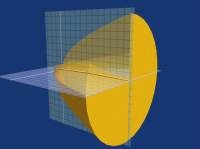
|

Vol_Using_Shells animation
An
animation of a parabola on a grid which is spun (lathed) on its Y
axis to produce a "bundt cake" shaped half-donut. From this
solid are highlighted rings, and one of the rings is pulled from the
solid, opened up into a flat strip and spun around to show its shape.
This introduces the topic of volume using the Shell method.
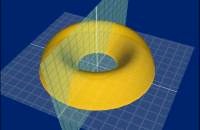
|

Piston Animation
This
animation demonstrates a related rate application over time using
a piston.
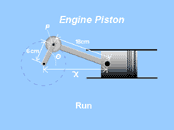 |
BaseRunner Animation
This
animations depicts a rate of change topic using the runner's position
relative to the home plate as he runs to third base.
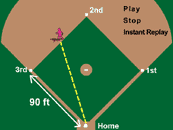 |
BaseRunner_and_ball animation
This
animations depicts a rate of change topic involving a baseball player trying to throw a runner out at 3rd base.
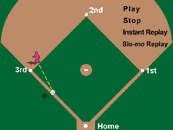
|
BaseRunnerHome_and_2nd animation
This
animations depicts a rate of change topic involving the distance between two base runners.
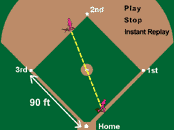 |
Cylinder_In_a_Sphere animation
An
animation of a blue wireframe globe spinning in place. Inside is a
semi-transparent cylinder that expands and shrinks from a tall slim
cylinder to a large diameter but thin slice of a cylinder and back
again, showing all the possible variations of size and volume of a
cylinder within a given sphere (a Max/Min problem).
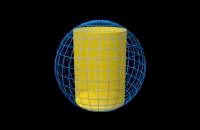
|
Cylinder_in_Sphere.jpg
and
Cylinder_in_Sphere_with_Labels.jpg
(used
in conjunction with the adjacent "Cylinder in a Sphere" animation)
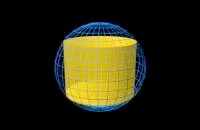
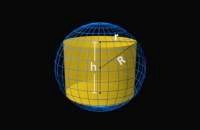
|
Silos animation
An
animation showing different views of four silos of different heights
and diameters, visualizing how the various parameters effect the size
and volume of the dome-shaped top. This is used to introduce a problem
involving calculating the most cost-effective construction of a silo
to hold a given volume of grain. The silo's domed top cannot be used
to store grain and its cost of construction per volume measurement
is greater than the cylindrical portion, thus creating the need to
get the most cylindrical volume vs. dome volume to reduce construction
cost for a given storage volume. (a Max/Min problem)
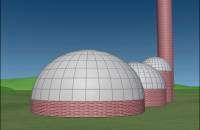
|
4_Silos_Front_View.jpg
One of several still images from the "Silos" animation, showing various views of four
silos, making it easier to visually compare the relative shapes and
sizes:
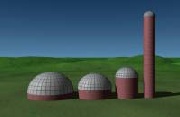
|
4_Silos_High_View.jpg
One of several still images from the "Silos" animation, showing various views of four
silos, making it easier to visually compare the relative shapes and
sizes:
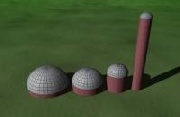
|
4_Silos_Oblique_View.jpg
One of several still images from the "Silos" animation, showing various views of four
silos, making it easier to visually compare the relative shapes and
sizes:
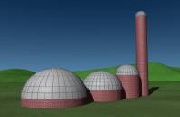
|
Silo_10x2.5.jpg
One of several still images from the "Silos" animation, showing various views of four
silos, making it easier to visually compare the relative shapes and
sizes:
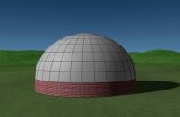
|
Silo_7.5x4.4.jpg
One of several still images from the "Silos" animation, showing various views of four
silos, making it easier to visually compare the relative shapes and
sizes:
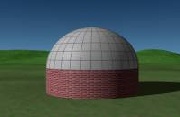
|
Silo_5x10.jpg
One of several still images from the "Silos" animation, showing various views of four
silos, making it easier to visually compare the relative shapes and
sizes:
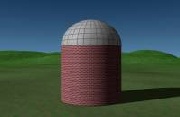 |
Silo_2.5x40.jpg
One of several still images from the "Silos" animation, showing various views of four
silos, making it easier to visually compare the relative shapes and
sizes:
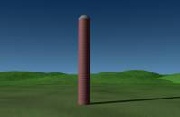 |
Silo_Transparent_ with_Labels.jpg
One of several still images from the "Silos" animation, showing various views of four
silos, making it easier to visually compare the relative shapes and
sizes:
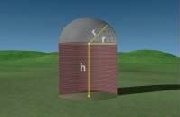 |
Silo_Transparent_no_Labels.jpg
One of several still images from the "Silos" animation, showing various views of four
silos, making it easier to visually compare the relative shapes and
sizes:
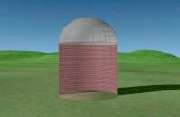 |
CannonTrajectory_anim.gif
An
animation showing the forces on a projectile at different points in
the flight path. Used for Calculus in solving differential equations
and also for Euler’s Method.
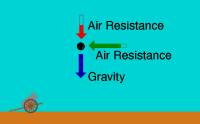 |
Picture4 animation
An
animation - girl viewing a painting on the wall. Painting is 3' high,
the bottom edge of it hangs 4' above the girl’s eyelevel. Find
distance X from the wall where the girls viewing angle is best.
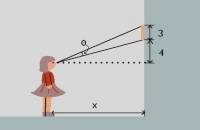 |
TreasureDig animation
An
animation - a pirate buries his treasure in the side of a mountian
that is an island. Picturing the island as a parabola on a grid, calculate
whether the shortest route to dig to the treasure is a vertical or
horizontal tunnel.
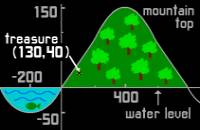 |
Skater_anim.gif
This
animation shows an overhead view of an ice skater skating in an ellipse,
which is superimposed on a coordinate plane. When the skater falls
down, she slides off at a tangent to the ellipse (related rates
problem).
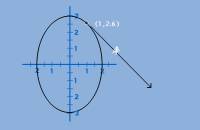 |
Tartown_anim.gif
In
this animation two friends are talking on cell phones, each traveling
in a car, one headed into Tartown, and one headed out of Tartown on
highways that are at right angles to each other. From this overhead
view, calculate the rate at which their distance from each other is
changing (related rates problem).
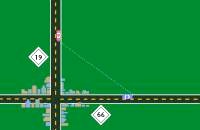 |
Balloon_anim.gif
An
animation showing a hot air balloon going up vertically at 90 degrees.
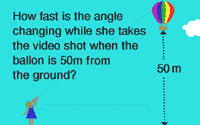 |
Balloon_70degrees_anim.gif
An
animation showing a hot air balloon going up vertically, but at a
70 degree angle to the ground.
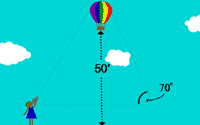 |
BoatPull_anim.gif
An
animation. A man on a pier uses a rope to pull his rowboat closer
to the pier. The rate of the boat’s approach changes with distance
to the pier (related rates problem).
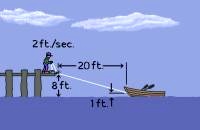 |
Plane-n-Camera_anim.gif
An
animation showing a girl watching an approaching airplane through
her video camera. The angle changes as the plane comes closer. (related
rates problem)
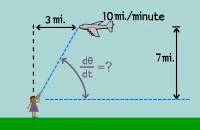 |
RugbyField_anim.gif
An
animation. A player wants to find the optimum angle from the sideline
to kick the ball into the goal so he has the widest possible target.
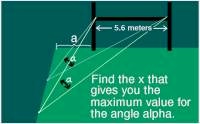 |
|
|

